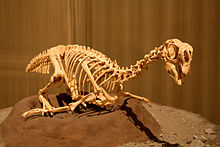Conchoraptor
| Conchoraptor | |
|---|---|

| |
| Cast mounted in a nesting position | |
| Scientific classification | |
| Domain: | Eukaryota |
| Kingdom: | Animalia |
| Phylum: | Chordata |
| Clade: | Dinosauria |
| Clade: | Saurischia |
| Clade: | Theropoda |
| Family: | †Oviraptoridae |
| Subfamily: | † Heyuanninae
|
| Genus: | †Conchoraptor Barsbold, 1986 |
| Species: | †C. gracilis
|
| Binomial name | |
| †Conchoraptor gracilis Barsbold, 1986
| |
Conchoraptor (meaning "
.Discovery

When first discovered in the
The
Description

Conchoraptor was a small dinosaur, only 1–2 meters (3.3-6.6 feet) in length. Unlike many other
Classification
Conchoraptor was by Barsbold assigned to the Oviraptoridae in 1986. Recent analyses show it was a member of the oviraptorid subfamily Ingeniinae (now Heyuanninae). The cladogram below follows an analysis by Fanti et al., 2012.[5]
| Oviraptoridae |
| |||||||||||||||||||||||||||||||||||||||
Paleobiology
Senses

Internal connections between both ears functioned as resonance chambers and improved hearing.[6]
Feeding
Originally it was suggested that Conchoraptor had a diet that primarily consisted of mollusks.[7][8][9] A 2022 study of the bite force of Conchoraptor and comparisons with other oviraptorosaurs such as Incisivosaurus, Citipati, and Khaan instead suggests that Conchoraptor had a very strong bite force. The moderate jaw gape seen in oviraptorosaurs is indicative of herbivory in the majority of the group, but it is clear they were likely feeding on much tougher or more various types of vegetation than other herbivorous theropods in their environment, such as ornithomimosaurs and therizinosaurs were able to. The examinations suggest oviraptorosaurs may have been powerful-biting generalists or specialists that partook of niche partitioning both in body size and cranial function.[10]
Paleoenvironment
The
Conchoraptor shared its habitat with other oviraptorosaurs including
See also
References
- ^ ISBN 0-7853-0443-6.
- ^ Barsbold, R. (1986). "Raubdinosaurier Oviraptoren". In Vorobyeva, E.I. (ed.). Herpetologische Untersuchungen in der Mongolischen Volksrepublik. Akademia Nauk SSSR. pp. 210–223.
- .
- S2CID 25723660.
- PMID 22347465.
- S2CID 40622976.
- ISSN 0008-4077.
- S2CID 128767044.
- ^ Mike, Walley (July 28, 2008). "Strange Dinosaur Called Conchoraptor". Everything Dinosaur Blog. Retrieved 2022-08-02.
- S2CID 247057480.
- ISBN 978-0-521-78142-8.
- ^ .
- ^ Novacek, M. J., 1996. "Dinosaurs of the Flaming. Cliffs" Anchor/Doubleday. 367 p.
External links
 Media related to Conchoraptor at Wikimedia Commons
Media related to Conchoraptor at Wikimedia Commons Data related to Conchoraptor at Wikispecies
Data related to Conchoraptor at Wikispecies
